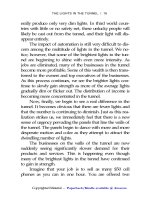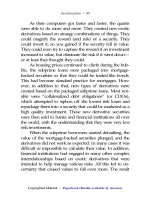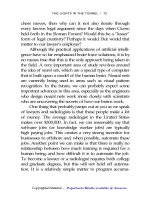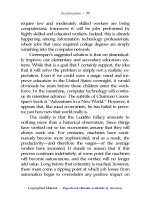The economy of ghana sixty years after independence
Bạn đang xem bản rút gọn của tài liệu. Xem và tải ngay bản đầy đủ của tài liệu tại đây (3.02 MB, 436 trang )
T H E E C O N O M Y O F GH A N A S I X T Y Y E A R S
AFTER INDEPENDENCE
The Economy of
Ghana Sixty Years
after Independence
Edited by
ERNEST ARYEETEY
and
RAVI KANBUR
1
OUP UNCORRECTED PROOF – FIRST PROOF, 6/1/2017, SPi
3
Great Clarendon Street, Oxford, OX2 6DP,
United Kingdom
Oxford University Press is a department of the University of Oxford.
It furthers the University’s objective of excellence in research, scholarship,
and education by publishing worldwide. Oxford is a registered trade mark of
Oxford University Press in the UK and in certain other countries
© the various contributors 2017
The moral rights of the authors have been asserted
First Edition published in 2017
Impression: 1
All rights reserved. No part of this publication may be reproduced, stored in
a retrieval system, or transmitted, in any form or by any means, without the
prior permission in writing of Oxford University Press, or as expressly permitted
by law, by licence or under terms agreed with the appropriate reprographics
rights organization. Enquiries concerning reproduction outside the scope of the
above should be sent to the Rights Department, Oxford University Press, at the
address above
You must not circulate this work in any other form
and you must impose this same condition on any acquirer
Published in the United States of America by Oxford University Press
198 Madison Avenue, New York, NY 10016, United States of America
British Library Cataloguing in Publication Data
Data available
Library of Congress Control Number: 2016950607
ISBN 978–0–19–875343–8 (hbk.)
978–0–19–879895–8 (pbk.)
Printed in Great Britain by
Clays Ltd, St Ives plc
Links to third party websites are provided by Oxford in good faith and
for information only. Oxford disclaims any responsibility for the materials
contained in any third party website referenced in this work.
Acknowledgements
The Editors would like to acknowledge the invaluable assistance of Sue Snyder of
Cornell University as the administrative anchor of the project.
Preface
Ghana will celebrate 60 years of independence in 2017. As one of the first
countries to receive independence in sub-Saharan Africa, Ghana’s development
has been followed with great interest by the development community. After a
period of high growth in the first two decades of independence the economy fell
into a deep slump through the 1980s. Economic recovery gathered pace through
the 1990s, alongside a restoration of democracy after a long period of intermittent
military rule.
At the 50th anniversary of Ghana’s independence in 2007, political stability and
economic growth gave some cause for optimism, even though it was noted by
many observers that Ghana’s economy had not achieved the structural transformation to a more diversified production base that was desired by policymakers. At
the same time, oil and gas discoveries held out the prospect for an oil boom which
could underpin further economic development, although there were worries
about the natural resource curse witnessed in many resource rich countries.
As Ghana approaches its 60th birthday, it would be fair to say that optimism
and worries for the future continue to be present in equal measure. Economic
growth in the last decade has been high by historical standards. Indeed, recent
rebasing of gross domestic product (GDP) figures has put Ghana over the per
capita income threshold into middle-income country status. However, structural
transformation has lagged behind. Further, fiscal discipline has eroded significantly and heavy borrowing especially on the commercial market is being engaged
in, while elements of the natural resource curse have already manifested themselves. The question most observers ask is whether the gains from two decades of
reforms are being reversed.
Given this background, this volume brings together leading established and
young economists, from within and outside Ghana, to analyse and assess the
challenges facing Ghana’s economy as it enters its seventh decade and the nation
heads towards three-quarters of a century of independence. The chapters in the
volume cover the major macroeconomic and sectoral issues, including fiscal and
monetary policy, trade and industrialization, agriculture, and infrastructure. The
volume also covers the full range of social issues including poverty and inequality,
education, health, gender, and social protection.
Our hope is that this volume will take its place as a contribution to the ongoing
debate and discussion on the future and the promise of Ghana’s economy to
fashion a better life for its citizens.
Ernest Aryeetey
Ravi Kanbur
Contents
List of Figures
List of Tables
List of Contributors
xi
xv
xix
PART I. THEMATIC ISSUES
1. Ghana at Sixty: Learning from a Developing African Nation’s Past
Ernest Aryeetey and Ravi Kanbur
3
2. W. Arthur Lewis and the Roots of Ghanaian Economic Policy
Ravi Kanbur
16
3. Property and Freedom
Franklin Obeng-Odoom
28
PART II. MACROECONOMY AND FINANCE
4. Economic Growth in Ghana: Trends and Structure, 1960–2014
Ernest Aryeetey and Ama Pokuaa Fenny
45
5. Sixty Years of Fiscal Policy in Ghana: Outcomes and Lessons
Robert Darko Osei and Henry Telli
66
6. Monetary Policy and Inflation Management in Ghana: Inflation
Targeting and Outcomes
Peter Quartey, Bernice Owusu-Brown, and Festus Ebo Turkson
88
7. Trade and Exchange Rate Policies since Independence and
Prospects for the Future
A. D. Amarquaye Laryea and Bernardin Senadza
103
8. Banking and Capital Markets: The Evolution of Ghana’s Financial
Sector and Future Prospects
Sam Mensah
117
9. Oil and Ghana’s Economy
Augustin Kwasi Fosu
137
PART III. SECTORAL PERSPECTIVES
10. Flickering Decades of Agriculture and Agricultural Policy
Fred Mawunyo Dzanku and Christopher Udry
11. Industrial Policy in Ghana: From a Dominant State to
Resource Abundance
Nkechi S. Owoo and John Page
157
176
x
Contents
12. Formal and Informal Enterprises as Drivers and
Absorbers of Employment
William F. Steel
13. Urbanization in Ghana: Retrospect and Prospects
George Owusu and Paul W. K. Yankson
14. State of Ghana’s Infrastructure and its Implications
for Economic Development
Edward Nketiah-Amponsah and Patricia Woedem Aidam
15. Managing the Environment for Development
Daniel K. Twerefou and K. A. Tutu
16. Mining in Ghana: Critical Reflections on a Turbulent Past
and Uncertain Future
Gavin Hilson and Abigail Hilson
192
207
223
242
261
PART IV. HUMAN DEVELOPMENT
17. Inequality and Poverty in Ghana
Andy McKay and Eric Osei-Assibey
279
18. Employment and Labour Market
William Baah-Boateng
299
19. Closing the Gender Gaps in Ghana
Abena D. Oduro and Charles G. Ackah
317
20. The Prospects and Challenges of a Youthful Population in
Achieving Economic and Social Transformation in Ghana
Emmanuel A. Codjoe
333
21. Education in Ghana: Access, Quality, and Prospects for Reforms
Kwabena Gyimah-Brempong
349
22. Health and Healthcare in Ghana, 1957–2017
Ama de-Graft Aikins and Kwadwo Koram
365
23. Social Health Insurance in Ghana: The Politics, Economics,
and the Future
Isaac Osei-Akoto and Clement Adamba
385
Index
401
List of Figures
4.1. GDP growth rate, 1960–2014
4.2. GDP growth, 1960–1983
46
47
4.3.
4.4.
4.5.
4.6.
Capital investment, 1960–1983
Savings; value and share of GDP, 1975–1983
Money supply growth, 1960–1983
Trade balance as per cent of GDP
49
50
51
52
4.7.
4.8.
4.9.
4.10.
GDP growth, 1983–1995
GDP growth, 1995–2010
Sectoral contributions to GDP, 1996–2009
Budget deficit, 1996–2008
53
56
57
58
4.11.
5.1.
5.2.
5.3.
5.4.
Trends in exports and imports, 1993–2010
Trends in overall fiscal deficits for Ghana, 1950–2014
Trends in broad government expenditures for Ghana, 1950–2014
Trends in broad government fiscals for Ghana, 1950–2014
Trends in tax and non-tax revenue for Ghana, 1950–2014
59
69
69
70
71
Trends in the extent of slippages for Ghana, 2005–2014
Scatter plot of deficits and government expenditures for Ghana, 1970–2014
Scatter plot of deficits and government expenditures for Ghana, 1970–2014
Scatter plot of deficits and government revenues for Ghana, 1970–2014
75
76
76
77
5.5.
5.6.
5.7.
5.8.
5.9. Fiscal deficits and GDPPC growth for selected years, Ghana and comparator
countries
5.10. Expenditure and GDPPC growth for selected years, Ghana and comparator
countries
5.11. Government revenue and GDPPC growth for selected years, Ghana and
comparator countries
5.12. Correlates of growth and fiscal indicators for Ghana, 1957–2014
6.1. Transmission mechanism
6.2. Interest rates, 2003–2014
79
80
81
82
91
95
6.3.
7.1.
7.2.
7.3.
Monetary policy regimes, money growth, and inflation rates, 1970–2014
Growth of per capita real GDP (%), 1961–2013
Total trade as per cent of GDP, 1961–2013
Trade deficit as per cent of GDP, 1961–2013
97
112
112
113
7.4.
8.1.
8.2.
8.3.
External debt as per cent of GNI, 1961–2012
The dialectic of financial sector change in Ghana
Nominal and real interest rates, 1971–1983
Market capitalization/GDP
115
118
123
128
8.4. Number of listed companies, 1991–2014
129
xii
List of Figures
8.5. Interest rate spread, 2014
9.1. Share of petroleum output in GDP (%)
133
138
9.2.
9.3.
9.4.
9.5.
9.6.
139
139
140
140
142
Share of petroleum output in industry (%)
Sectoral patterns of the Ghanaian economy, 2000–2014
Share of petroleum output in mining and quarrying (%)
Share of petroleum exports in total exports (%)
Share of petroleum revenue in domestic revenue (%)
9.7. Ghana’s petroleum revenue allocation
10.1. A negative relationship is observed between agricultural GDP share and
economic growth, 1960–2014
146
159
10.2. Relationship between agricultural productivity and labour shift from
agriculture to nonagriculture, 1960–2014
10.3. Agricultural value added growth has been much more erratic than overall
GDP growth
10.4. There is a positive association between cocoa producer price and output,
1957–2014
11.1. Sectoral contributions to GDP, 1970–1984
11.2. Share of sub-sector in total industrial GDP
11.3. Sub-sectoral contributions to industrial GDP, 2006–2012
166
178
179
181
12.1.
12.2.
12.3.
12.4.
195
197
198
199
Sectoral composition of GDP, 1957–2013
Male and female active employment participation rates, 1960–2013
Shares in total employment (ages 15–64), 1960–2013
Shares of employment absorption by period, 1960–2013 (%)
12.5. Detailed shares of employment absorption, 1992–2006 and 2006–2013
12.6. Sectoral distribution of informal self-employment, 1991–1992 and
2005–2006
13.1. Ghana: urbanization growth rate and real GDP growth rate
14.1. Ghana’s air transport freight in relation to her comparator countries
14.2. Ghana’s internet users (per 100 people) in relation to her
comparator countries
14.3. Ghana’s telephone lines (per 100 people) in relation to her
comparator countries
14.4. Ghana’s paved road (% of total roads) in relation to her comparator
countries
15.1. Trends in emissions by type of gas (TgCO2e)
160
162
200
203
208
232
233
233
234
246
15.2. Annual freshwater withdrawals by sector as a percentage of total
freshwater withdrawal
15.3. Trends in resource rent as a percentage of GDP
253
254
16.1.
17.1.
17.2.
17.3.
17.4.
268
292
293
294
295
Mineral revenue in Ghana, 2013 (US$ millions)
Highest educational level: secondary or higher by wealth quintile, 1988–2008
Under-five mortality per 1000 live births, 1993–2008
Vaccinations by background characteristics, 1993 and 2008
Trends in stunting, underweight and wasting, 1988–2008
List of Figures
18.1. Educational attainment of Ghanaian workforce, 1960–2013 (%)
18.2. Growth of employment and GDP, 1960–2013
18.3a.
18.3b.
18.4.
18.5.
20.1.
Employment distribution by economic sector, 1960–2013 (%)
Sectoral composition of GDP, 1960–2014 (%)
Real national daily minimum wage and earnings
Unemployment by level of education
Trends in population size, 1921–2015
xiii
302
303
304
304
307
310
334
20.2. Ghana population pyramid, 2010
22.1. The WHO health systems building blocks (concepts and strategies for
strengthening health systems)
336
370
23.1. Change in total revenue of the NHIF and claims paid to service
providers (%)
391
List of Tables
3.1. Private land purchases in Ghana
3.2. Corporate land investment-driven displacements, 2002–2012
31
33
4.1.
4.2.
4.3.
4.4.
Average annual real growth of GDP and agriculture
Industrial sector performance, 1971–1983
Fiscal deficit, 1970–1983
Contribution from oil to GDP, 2010–2014
48
48
50
60
4.5.
4.6.
5.1.
6.1.
Growth by sector, 2010–2014
Actual oil revenue relative to selected fiscal indicators
Pairwise Granger causality tests for GDP and other fiscal variables
Monetary policy and target
61
61
84
89
6.2.
8.1.
8.2.
8.3.
8.4.
Selected macroeconomic indicators, 2003–2014
Financial Sector Indicators, 1970–1983
Size and concentration of banks, 1989–1996
Stock market indicators for selected African markets, 2012
Selected banking indicators
96
122
126
129
131
8.5.
9.1.
9.2.
9.3.
Growth of capital market institutions in Ghana
Real GDP growth rates: overall and non-oil (%)
Oil and developments in balance of payments (USD mil.)
Sources of petroleum revenue, 2011–2014
132
138
141
141
9.4. Terms of trade, and Ghana’s economic growth and export performance (%)
9.5. Distributed-lag regression results: terms of trade and Ghana’s GDP growth,
1960–2007 (dependent variable = GGDP)
9.6. Distribution of petroleum receipts, 2011–2014 (US$ millions,
unless indicated)
9.7. Measures of institutional quality (IQ)—Ghana vs. SSA, 2011–2014
10.1. Both agricultural employment share and agricultural GDP share has been
declining over time
10.2. There is a strong link from agricultural growth to non-agricultural growth,
the reverse is not so strong
10.3. Growth in overall and agricultural performance since independence (%)
10.4. Growth performance of some agriculture sub-sector indicators (%)
10.5. Proportion of household involved in agricultural production
10.6. In most cases farm sizes have either increased marginally or remained
largely unchanged
10.7. Yields have generally been erratic and much lower than that provided
by the macro data
10.8. The share of households using chemical fertilizer and quantity of fertilizer
use is increasing over time
143
144
149
151
158
161
163
164
168
168
169
170
xvi
List of Tables
10.9. Combining non-exports with non-farm work is not welfare reducing,
particularly in rural areas
10.10. Average partial effects and elasticities of poverty with respect to
agricultural productivity
171
173
12.1. Public and private shares of formal wage employment (ages 15–64),
1992–2013
12.2. Summary of strategy, sectors, and employment trends by period
197
202
13.1. Proportion of urban population and annual growth rate, national and
region, 1960–2010
13.2. Selected list of urban development and related policies
209
215
14.1.
14.2.
14.3.
14.4.
14.5.
225
227
228
229
230
Progress on some of the projects from 2012–2014
Overview of aircraft, passenger, and freight movement (international)
Main sources of water supply for drinking per locality
Proportion of population using improved drinking water sources (total)
Transmission losses since 2008
14.6. Pearson correlation analysis of the relationship between economic growth
and infrastructural development variables
15.1. Some environmental related policies and legislation
237
245
16.1.
16.2.
16.3.
16.4.
Contribution of GDP by economic activity, Ghana
Royalties from mining
Trends in manufacturing in Ghana, 1970–1990
Oil production in sub-Saharan Africa, thousand barrels of oil per day
266
267
267
274
17.1.
17.2.
17.3.
17.4.
Some socio-economic indices by administrative region, 1970s
Some socio-economic indices by administrative region, 2000s
Stock of houses and annual rate of increase, 1960–2010
Consumption poverty in Ghana from the first three GLSS surveys
282
282
283
286
17.5. Consumption poverty in Ghana, 1991–1992 to 2005–2006
17.6. Poverty in Ghana, 2005–2006 to 2012–2013
17.7. Trends in consumption-based inequality in Ghana, 1987–1988
to 2012–2013
17.8. Highest educational level: Secondary or higher by region, 1988–2008
17.9. Under-five mortality by region, 1998–2008
17.10. Regional distribution of doctors (population per doctor)
18.1. Trend and distribution of employment, 1960–2013
18.2.
18.3.
18.4.
19.1.
Female–male ratio of sex representation (incidence) in employment
Unemployment rates, by age, sex, and location (%)
Underemployment rates by sex and location for aged 15+ (%)
Performance in the Basic Education Certificate Examination, 2012 (%)
19.2. Composition of employment by industry, persons aged 15 years
and above (%)
19.3. Employment status of women and men aged 15 years and above (%)
287
288
289
292
293
295
300
306
309
311
325
326
327
List of Tables
19.4. Average time spent on activities by persons aged 18 years and
above (in minutes)
19.5. Women’s share of gross household wealth and incidence of ownership of
agricultural land and businesses (%)
20.1. Youth school attendance rates by age category and gender, 2000 and 2010
(in percentages)
20.2. Employment status of persons aged 15 years and older by locality and
gender, 2012–2013 (in percentages)
20.3. Activity rates by age categories and gender, 1960–2010 (in percentages)
20.4. Type of work engaged in by currently employed population aged 15 years
and older by locality and gender, 2012–2013 (in percentages)
20.5. Economically active population 15+ years by employment sector and sex
20.6. Employment status of economically active population by gender, 2010
21.1.
21.2.
21.3.
21.4.
22.1.
Educational attainment in Ghana, 2010
Enrolment rates over time
Enrolment rate by gender in Ghana
Other educational statistics, 2005, 2010, and 2014
Ranks for top 25 causes of premature deaths in Ghana, 1990, 2010
22.2. Health facilities by type and (public/private) ownership, 2007
22.3. Health professionals: population ratio, 2006–2012
22.4. Ghana—National expenditure on health, 2000–2013
xvii
328
329
337
338
339
339
342
342
350
354
356
357
367
372
374
379
List of Contributors
Charles G. Ackah, University of Ghana
Clement Adamba, University of Ghana
Patricia Woedem Aidam, University of Ghana
A. D. Amarquaye Laryea, University of Ghana*
Ernest Aryeetey, University of Ghana
William Baah-Boateng, University of Ghana
Emmanuel A. Codjoe, University of Ghana
Robert Darko Osei, University of Ghana
Ama de-Graft Aikins, University of Ghana
Fred Mawunyo Dzanku, University of Ghana
Ama Pokuaa Fenny, University of Ghana
Augustin Kwasi Fosu, University of Ghana
Kwabena Gyimah-Brempong, University of South Florida
Abigail Hilson, Royal Holloway University of London
Gavin Hilson, University of Surrey
Ravi Kanbur, Cornell University
Kwadwo Koram, University of Ghana
Andy McKay, University of Sussex
Sam Mensah, University of Ghana
Edward Nketiah-Amponsah, University of Ghana
Franklin Obeng-Odoom, University of Technology Sydney
Abena D. Oduro, University of Ghana
Isaac Osei-Akoto, University of Ghana
Eric Osei-Assibey, University of Ghana
Nkechi S. Owoo, University of Ghana
George Owusu, University of Ghana
Bernice Owusu-Brown, University of Ghana
John Page, Brookings Institution
Peter Quartey, University of Ghana
Bernardin Senadza, University of Ghana
William F. Steel, University of Ghana
Henry Telli, International Growth Centre
* We are sad to record that A. D. Amarquaye Laryea passed away during the final
stages of the preparation of this volume.
xx
List of Contributors
Festus Ebo Turkson, University of Ghana
K. A. Tutu, University of Ghana
Daniel K. Twerefou, University of Ghana
Christopher Udry, Yale University
Paul W. K. Yankson, University of Ghana
Part I
Thematic Issues
1
Ghana at Sixty
Learning from a Developing African Nation’s Past
Ernest Aryeetey and Ravi Kanbur
1. 1 IN TR O D U C T I O N
Many Ghanaians like to remind themselves and the world that Ghana was the
first country in sub-Saharan Africa to be returned to independent status following agitations to break away from colonial rule in many parts of Africa in the
1950s. For many Ghanaians, that achievement signalled tenacity of purpose and
a strong desire to lead the rest of Africa into a new era of transformation and a
better life for all. They took the fight for independence seriously considering
that the Gold Coast, as it then was, had a relatively large number of educated
persons and educational institutions compared to many other places in the region
(Wallerstein, 1964).
As Ghanaians celebrated fifty-nine years of independence in March 2016, many
newspaper articles expressed doubts about the extent to which expectations at
independence had been met. Most conveyed the perception that the high expectations that accompanied the independence celebrations had not materialized.1
The people of Ghana had expected rapid industrialization, employment for all,
higher incomes, a more democratic system of governance, greater access to
education and healthcare, and general improvements in welfare. The idea that
these had not been realized to the extent that many had thought was coming, was
quite pervasive as reported by most newspapers covering the fifty-ninth independence celebrations.
The view that expectations had not been met was presented against a backdrop
of economic uncertainty and weakened economic performance. By the end of
2015 gross domestic product (GDP) growth was at 3.5 per cent for the year. By the
end of March 2016, inflation stood at 19.2 per cent and unemployment was
estimated to be more than 6 per cent. A year of very poor power supply had left
1
In the editorial of the Daily Graphic of Monday 8 March 2016, it was noted that ‘the flame of
national passion has died, and even though the President lighted the symbolic flame on 6 March to
symbolize (the) passion that spearheaded national development, that symbolic gesture was probably a
futile attempt to reignite a passion that no longer exists’.
4
Ernest Aryeetey and Ravi Kanbur
many manufacturing enterprises struggling. It had been estimated that erratic
power supply had cost the small and medium enterprise sector in Ghana an
average of $2.2 million daily or 2 per cent of GDP in 2015 (ISSER, 2015).
The recent economic challenges of Ghana saw it return to the adoption of an
International Monetary Fund (IMF) programme in April 2015 after almost a
decade, when a $900 million financing arrangement was put in place. The IMF
noted that ‘Ghana, considered one of West Africa’s most stable democracies, until
recently was a model for economic growth. However, the economy has taken a
turn for the worse, with growth down from 8 per cent in 2012 to 3.5 per cent in
2015’ (IMF Survey, 2016). At the time the programme was agreed the fiscal deficit
had been as high as 10.6 per cent of GDP and went down to 6.7 per cent in 2015.
In effect the state of the economy has been quite shaky in the years leading up to
the sixtieth anniversary celebrations of independence, thus feeding into the
widespread perceptions that expectations had not been met.
There is obviously a lot more to consider in determining how the Ghanaian
economy has performed over the post-independence period compared with what
has been seen in the last few years. The irony, however, is that the period of poor
performance in the last few years is not peculiar. The various reviews in this book
will show that there have been several periods of similar poor economic performance since independence, interspersed with some periods of good performance
and very high expectations. What is also clear is that the periods of poor
performance have almost always been associated with poor economic policies
and weak economic management. By poor economic policies, we mean policies
and actions associated with fiscal indiscipline and poor budgetary policies often
associated with strong political influences and considerations. This is in addition
to various structural and institutional bottlenecks that make poor policymaking
and implementation possible.
In this overview chapter, we first provide a pre-independence account of the
state of the economy and how that economy was managed in section 1.2. It is
followed by a short presentation in section 1.3 of economic policymaking in the
first two and a half decades after independence which we call the pre-reform years.
The same process in the reform and post-reform years beginning in 1983 are
discussed in section 1.4. Beginning from section 1.5 we introduce the stories of
each chapter in this volume in relation to how they reflect the general theme of
understanding the relationship between economic policymaking and economic
performance.
1 . 2 F R O M G U G G I S B E R G T O IN D E P E N D E N C E ( 1 9 1 9 –1 9 5 7 )
In 1919, when Sir Gordon Guggisberg took office as Governor of the Gold Coast,
the colony had experienced twenty years of very high growth due to predominantly high returns from cocoa exports, and this was despite the occurrence of the
First World War. Guggisberg’s ambition was to sustain this growth and prosperity
by channelling the newly-obtained resources into important sections of the
economy such as health, education and other human capital development. His
plan to further develop the infrastructural state of the colony would facilitate









